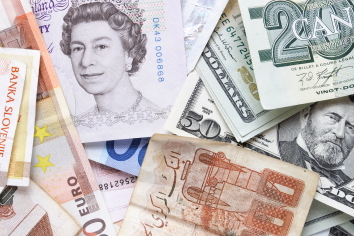Currency ETFs: Another Way to Trade Forex
 What is a currency ETF? – A currency ETF is a fund instrument that tracks the performance of a basket of currencies or even a single currency.
What is a currency ETF? – A currency ETF is a fund instrument that tracks the performance of a basket of currencies or even a single currency.
How Currency ETFs Work
Currency ETFs can track a single currency or they can track several currencies. ETFs that track currencies operate in two ways:
a) They may be designed to track the price of a currency or a selection of currencies, acting as a derivative. In this case, the ETF would invest in units of the currency, or in contracts which hold a block of units for that currency.
b) They may actually be made up of a cash investment in the currency or currencies that are being tracked by the ETF.
In either case, the goal of the currency ETF is simply to correlate itself via these two methods to the price and performance of the currency or currencies invested in, and not to outperform that currency asset(s).
A popular saying in the financial world is that “there is always a bull market somewhere”, and this is what currency ETFs are designed to identify: a currency bull market somewhere.
Trading in the spot forex market is risky, and the forex futures markets are even more risky. It is expensive, and the trader’s ability to spot profitable trends alone will not lead to a positive outcome in these markets. There are several phenomena to contend with: slippage, arbitrage, news trades, leverage, margin, etc. Getting any of these factors all wrong will lead to a losing streak and the aim of trading, which is to make money will be defeated. Currency ETFs simplify the process of participating in the currency market and eliminate some of the risk factors that some of these market phenomena bring to the plate.
Currency ETF Investment Strategies
Currency ETFs can be traded on the buy or sell side.
Currency ETF Buys: For instance, a trader may want to buy a currency ETF on a currency if he expects that currency to appreciate against another currency or other currencies, or buy an inverse currency ETF that tracks a currency he expects to fall in value.
Currency ETF Sell Trades: An ETF is a contract for difference instrument which can be traded long or sold short. Therefore, it is possible to make money by shorting a currency ETF that tracks a currency that the trader expects to drop in value against other currencies. He may also decide to short an inverse currency ETF on a currency that he expects to gain over time. Shorting a currency ETF directly tracking a currency that the trader expects to drop in value can be very profitable especially as there are many adverse events that could negatively impact a nation’s currency. If you had sold a currency ETF tracking the Euro since April 2010, you would have made an insane amount of money. The same effect would have been achieved by going long on an inverse ETF tracking the Euro such as the UltraShort Euro ProShares (NYSEArca: EUO). EUO is a currency ETF that aims to deliver twice the daily inverse performance of the Euro vs. the US Dollar. Look at the inverse relationship between the EUO and the EURUSD.

EURUSD chart from March to November 2012 showing movement of the Euro and fundamentals of the price movement.
EUO chart showing inverse relationship between this ETF and the Euro movement in previous chart. © ETFDailynews.com
This example is a very simplified example that would only work if the trader is purchasing or selling a currency ETF that tracks one or two currencies that the trader expects to move in tandem in the same direction. Such strategies will not work when there are a basket of currencies being tracked by the currency ETF. In such cases, a more careful approach to selection of the ETF in order to get a right mix of currencies for your trades would be the way to go.
Advantages of Currency ETFs
There are numerous advantages to using currency ETFs as a method of investing in the forex market as opposed to traditionally investing directly into the spot or futures forex market. These can be summarized as follows:
a) They are much easier to trade. A trader who wants to short or go long on an ETF can simply log into his stock account and place the trade on the ETF without having to figure out leverage and margin requirements, or without being taken out by a news trade-induced slippage.
b) Lower taxation, which occurs because currency ETFs are only taxed when a trade is made.
c) A single transaction can equate to up to three or more in the spot forex market when trading a currency ETF basket.
d) Easier to manage than hedge funds, since the ETF is only trying to match the performance of a currency asset and not to beat its performance.
e) Transaction costs are generally lower than when investing in other derivative instruments and hedge funds.
Disadvantages of Currency ETFs
Currency ETFs also have their disadvantages, and one of the major ones is that it is more difficult to trade a currency ETF made up of a basket of several currencies with different behaviors and attributes. For instance, trading an ETF which contains two assets with inverse price movements will be difficult, and any gains or losses on that ETF will depend on the weight of a currency against another.
Long trades on an ETF that tracks the performance of a currency directly can easily be taken out by a variety of factors.
Nevertheless, currency ETFs still present a sound way of investing and just like any other investment model, the trader should simply study how to trade them for maximum profits.